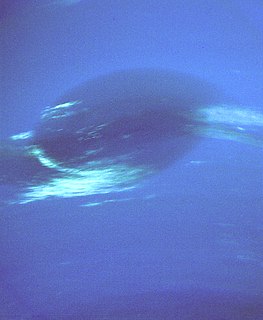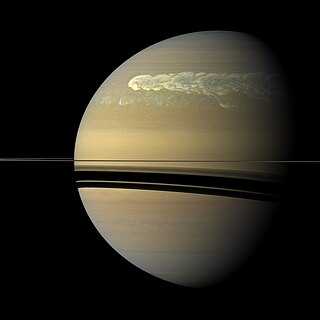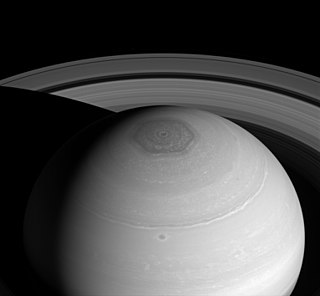 W
WDragon Storm is located in Saturn's Southern hemisphere, which is labeled as the "Storm Alley" region. The storm can have a range of 2,000 miles (3,200 km) and more. The Dragon Storm is a dramatic giant thunderstorm that can be compared to the electric thunderstorms on Earth. It acquires its energy in the deep layers of Saturn's atmosphere. The storms produce radio waves that reflect during its burst of short static which helped Cassini detect it.
 W
WThe Great Dark Spot was one of a series of dark spots on Neptune similar in appearance to Jupiter's Great Red Spot. GDS-89 was the first Great Dark Spot on Neptune to be observed in 1989 by NASA's Voyager 2 spaceprobe. Like Jupiter's spot, Great Dark Spots are anticyclonic storms. However, their interiors are relatively cloud-free, and unlike Jupiter's spot, which has lasted for hundreds of years, their lifetimes appear to be shorter, forming and dissipating once every few years or so. Based on observations taken with Voyager 2 and since then with the Hubble Space Telescope, Neptune appears to spend somewhat more than half its time with a Great Dark Spot.
 W
WThe Great Red Spot is a persistent high-pressure region in the atmosphere of Jupiter, producing an anticyclonic storm, the largest in the Solar System, 22 degrees south of Jupiter's equator. Observations from 1665 to 1713 are believed to be of the same storm; if this is correct, it has existed for at least 360 years. It was next observed in September 1831, with 60 recorded observations between then and 1878 when continuous observations began.
 W
WThe Great White Spot, also known as Great White Oval, on Saturn, named by analogy to Jupiter's Great Red Spot, are periodic storms that are large enough to be visible from Earth through telescope by their characteristic white appearance. The spots can be several thousands of kilometers wide.
 W
WThe atmosphere of Jupiter is the largest planetary atmosphere in the Solar System. It is mostly made of molecular hydrogen and helium in roughly solar proportions; other chemical compounds are present only in small amounts and include methane, ammonia, hydrogen sulfide, and water. Although water is thought to reside deep in the atmosphere, its directly measured concentration is very low. The nitrogen, sulfur, and noble gas abundances in Jupiter's atmosphere exceed solar values by a factor of about three.
 W
WSaturn's hexagon is a persistent hexagonal cloud pattern around the north pole of the planet Saturn, located at about 78°N. The sides of the hexagon are about 14,500 km (9,000 mi) long, which is about 2,000 km (1,200 mi) longer than the diameter of Earth. The hexagon may be a bit more than 29,000 km (18,000 mi) wide, may be 300 km (190 mi) high, and may be a jet stream made of atmospheric gases moving at 320 km/h (200 mph). It rotates with a period of 10h 39m 24s, the same period as Saturn's radio emissions from its interior. The hexagon does not shift in longitude like other clouds in the visible atmosphere.
 W
WThe Small Dark Spot, sometimes also called Dark Spot 2 or The Wizard's Eye, was an extraterrestrial vortex on the planet Neptune. It was the second largest southern cyclonic storm on the planet in 1989, when Voyager 2 flew by the planet. When the Hubble Space Telescope observed Neptune in 1994, the storm had disappeared.
 W
WNeptune is the eighth and farthest-known Solar planet from the Sun. In the Solar System, it is the fourth-largest planet by diameter, the third-most-massive planet, and the densest giant planet. It is 17 times the mass of Earth, slightly more massive than its near-twin Uranus. Neptune is denser and physically smaller than Uranus because its greater mass causes more gravitational compression of its atmosphere. The planet orbits the Sun once every 164.8 years at an average distance of 30.1 AU. It is named after the Roman god of the sea and has the astronomical symbol ♆, a stylised version of the god Neptune's trident.
 W
WThe climate of Titan, the largest moon of Saturn, is similar in many respects to that of Earth, despite having a far lower surface temperature. Its thick atmosphere, methane rain, and possible cryovolcanism create an analogue, though with different materials, to the climatic changes undergone by Earth during its far shorter year.